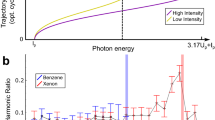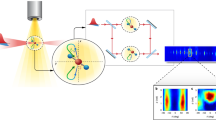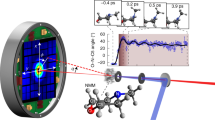Abstract
The study of chemical reactions on the molecular (femtosecond) timescale typically uses pump laser pulses to excite molecules and subsequent probe pulses to interrogate them. The ultrashort pump pulse can excite only a small fraction of molecules, and the probe wavelength must be carefully chosen to discriminate between excited and unexcited molecules. The past decade has seen the emergence of new methods that are also aimed at imaging chemical reactions as they occur, based on X-ray diffraction1, electron diffraction2 or laser-induced recollision3,4—with spectral selection not available for any of these new methods. Here we show that in the case of high-harmonic spectroscopy based on recollision, this apparent limitation becomes a major advantage owing to the coherent nature of the attosecond high-harmonic pulse generation. The coherence allows the unexcited molecules to act as local oscillators against which the dynamics are observed, so a transient grating technique5,6 can be used to reconstruct the amplitude and phase of emission from the excited molecules. We then extract structural information from the amplitude, which encodes the internuclear separation, by quantum interference at short times and by scattering of the recollision electron at longer times. The phase records the attosecond dynamics of the electrons, giving access to the evolving ionization potentials and the electronic structure of the transient molecule. In our experiment, we are able to document a temporal shift of the high-harmonic field of less than an attosecond (1 as = 10−18 s) between the stretched and compressed geometry of weakly vibrationally excited Br2 in the electronic ground state. The ability to probe structural and electronic features, combined with high time resolution, make high-harmonic spectroscopy ideally suited to measuring coupled electronic and nuclear dynamics occurring in photochemical reactions and to characterizing the electronic structure of transition states.
This is a preview of subscription content, access via your institution
Access options
Subscribe to this journal
Receive 51 print issues and online access
$199.00 per year
only $3.90 per issue
Buy this article
- Purchase on Springer Link
- Instant access to full article PDF
Prices may be subject to local taxes which are calculated during checkout




Similar content being viewed by others
References
Neutze, R., Wouts, R., van der Spoel, D., Weckert, E. & Hajdu, J. Potential for biomolecular imaging with femtosecond X-ray pulses. Nature 406, 752–757 (2000)
Ihee, H. et al. Direct imaging of transient molecular structures with ultrafast diffraction. Science 291, 458–462 (2001)
Itatani, J. et al. Tomographic imaging of molecular orbitals. Nature 432, 867–871 (2004)
Meckel, M. et al. Laser-induced electron tunnelling and diffraction. Science 320, 1478–1482 (2008)
Eichler, H. J., Gunter, P. & Pohl, D. W. Laser-Induced Dynamic Gratings Ch. 2–4 (Springer, 1986)
Mairesse, Y. et al. High-order harmonic transient grating spectroscopy in a molecular jet. Phys. Rev. Lett. 100, 143903 (2008)
Itatani, J. et al. Controlling high harmonic generation with molecular wave packets. Phys. Rev. Lett. 94, 123902 (2005)
Kanai, T., Minemoto, S. & Sakai, H. Quantum interference during high-order harmonic generation from aligned molecules. Nature 435, 470–474 (2005)
Wagner, N. L. et al. Monitoring molecular dynamics using coherent electrons from high harmonic generation. Proc. Natl Acad. Sci. USA 103, 13279–13285 (2006)
Li, W. et al. Time-resolved dynamics in N2O4 probed using high harmonic generation. Science 322, 1207–1211 (2008)
Le, V. H., Le, A. T., Xie, R. H. & Lin, C. D. Theoretical analysis of dynamic chemical imaging using high-order harmonic generation. Phys. Rev. A 76, 013414 (2007)
Rakitzis, T. P. & Kitsopoulos, T. N. Measurement of Cl and Br photofragment alignment using slice imaging. J. Chem. Phys. 116, 9228–9231 (2002)
Kanai, T., Takahashi, E. J., Nabekawa, Y. & Midorikawa, K. Destructive interference during high harmonic generation in mixed gases. Phys. Rev. Lett. 98, 153904 (2007)
Wörner, H. J., Niikura, H., Bertrand, J. B., Corkum, P. B. & Villeneuve, D. M. Observation of electronic structure minima in high-harmonic generation. Phys. Rev. Lett. 102, 103901 (2009)
Smirnova, O. et al. High harmonic interferometry of multi-electron dynamics in molecules. Nature 460, 972–977 (2009)
Corkum, P. B. Plasma perspective on strong-field multiphoton ionization. Phys. Rev. Lett. 71, 1994–1997 (1993)
Lein, M., Hay, N., Velotta, R., Marangos, J. P. & Knight, P. L. Role of the intramolecular phase in high-harmonic generation. Phys. Rev. Lett. 88, 183903 (2002)
Nugent-Glandorf, L. et al. Ultrafast time-resolved soft x-ray photoelectron spectroscopy of dissociating Br2 . Phys. Rev. Lett. 87, 193002 (2001)
Nugent-Glandorf, L., Scheer, M., Samuels, D. A., Bierbaum, V. M. & Leone, S. R. Ultrafast photodissociation of Br2: laser-generated high-harmonic soft x-ray probing of the transient photoelectron spectra and ionization cross sections. J. Chem. Phys. 117, 6108–6116 (2002)
Wernet, P. et al. Real-time evolution of the valence electronic structure in a dissociating molecule. Phys. Rev. Lett. 103, 013001 (2009)
Zimmermann, B. et al. Localization and loss of coherence in molecular double-slit experiments. Nature Phys. 4, 649–655 (2008)
Huber, K. P. & Herzberg, G. Molecular Spectra and Molecular Structure Vol. IV, Constants of Diatomic Molecules 106–108 (Van Nostrand Reinhold, 1979)
Gessner, O. et al. Femtosecond multi-dimensional imaging of a molecular dissociation. Science 311, 219–222 (2006)
Bisgaard, C. Z. et al. Time-resolved molecular frame dynamics of fixed-in-space CS2 molecules. Science 323, 1464–1468 (2009)
Wang, Z.-M. & Elliott, D. S. Determination of cross sections and continuum phases of rubidium through complete measurements of atomic multiphoton ionization. Phys. Rev. Lett. 84, 3795–3798 (2000)
Park, H. & Zare, R. N. Molecular-orbital decomposition of the ionization continuum for a diatomic molecule by angle- and energy-resolved photoelectron spectroscopy. II. Ionization continuum of NO. J. Chem. Phys. 104, 4568–4580 (1996)
Lezius, M. et al. Nonadiabatic multielectron dynamics in strong field molecular ionization. Phys. Rev. Lett. 86, 51–54 (2001)
Litvinyuk, I. V. et al. Shakeup excitation during optical tunnel ionization. Phys. Rev. Lett. 94, 033003 (2005)
Domcke, W., Yarkony, D. R. & Köppel, H. (eds) Conical Intersections: Electronic Structure, Dynamics and Spectroscopy (Adv. Ser. in Phys. Chem., Vol. 15, World Scientific, 2004)
Bucksbaum, P. H. The future of attosecond spectroscopy. Science 317, 766–769 (2007)
Acknowledgements
Funding from Canadian Institute for Photonic Innovation, NSERC and AFOSR is acknowledged. H.J.W. thanks the Swiss National Science Foundation (SNF) for a fellowship.
Author information
Authors and Affiliations
Contributions
D.M.V. proposed the experiment. H.J.W. and J.B.B. performed the experiments. J.B.B. assembled the transient grating set-up. H.J.W. proposed and conducted the data analysis. J.B.B. and D.V.K. performed a preliminary experiment. D.M.V. and H.J.W. did the theoretical calculations. H.J.W., J.B.B, P.B.C. and D.M.V. interpreted the data and wrote the Letter.
Corresponding author
Ethics declarations
Competing interests
The authors declare no competing financial interests.
Supplementary information
Supplementary Information
This file contains Supplementary Figures S1-S5 with legends, Supplementary Theoretical Information (1-5), Supplementary Experimental Data (6), Supplementary Results (7) and References. (PDF 984 kb)
Rights and permissions
About this article
Cite this article
Wörner, H., Bertrand, J., Kartashov, D. et al. Following a chemical reaction using high-harmonic interferometry. Nature 466, 604–607 (2010). https://doi.org/10.1038/nature09185
Received:
Accepted:
Issue Date:
DOI: https://doi.org/10.1038/nature09185
This article is cited by
-
Rebuilding the vibrational wavepacket in TRAS using attosecond X-ray pulses
Communications Physics (2024)
-
Ionization of hydrogen atom driven by ultrashort intense laser pulses: study in momentum space of phase-dependent effects
Indian Journal of Physics (2024)
-
High-harmonic spectroscopy of low-energy electron-scattering dynamics in liquids
Nature Physics (2023)
-
Orbital perspective on high-harmonic generation from solids
Nature Communications (2023)
-
Progress and prospects in nonlinear extreme-ultraviolet and X-ray optics and spectroscopy
Nature Reviews Physics (2023)
Comments
By submitting a comment you agree to abide by our Terms and Community Guidelines. If you find something abusive or that does not comply with our terms or guidelines please flag it as inappropriate.



